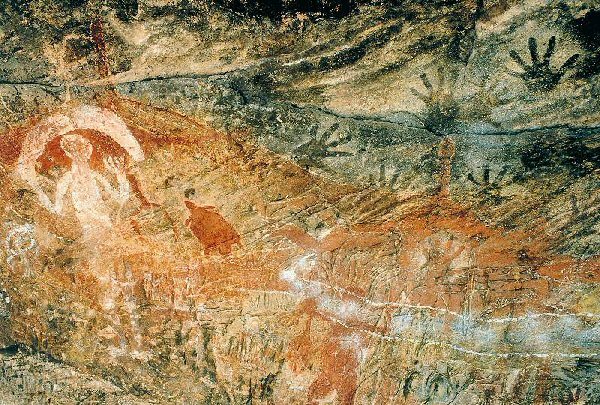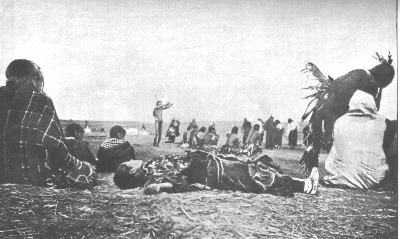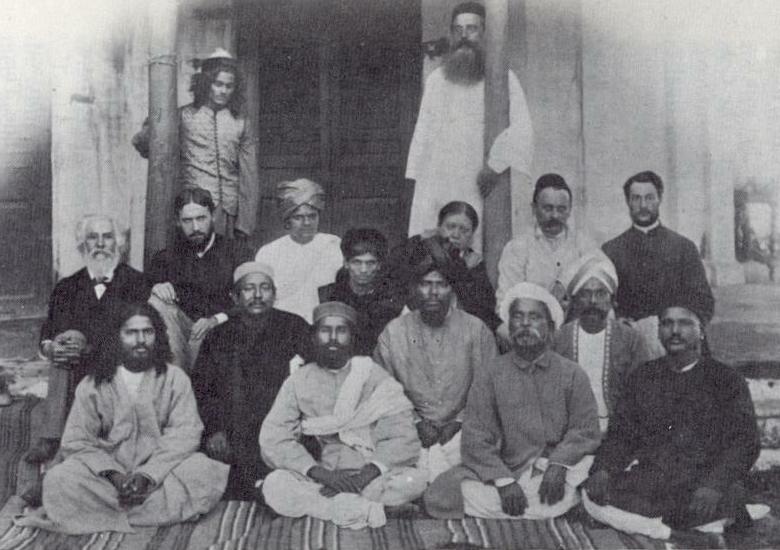
Crowley's model of the three schools of Magick, represented by the three Magi, seems accurate. It is a model that I add to my own, although reality is undoubtedly even more muddled and miraculous than even old Uncle Al lets on. These ideas are fun to play with.
It is customary to describe these three Schools as Yellow, Black, and White. The first thing necessary is to warn the reader that they must by no means be confounded with racial distinctions of colour; and they correspond still less with conventional symbols such as yellow caps, yellow robes, black magick, white witchcraft, and the like. The danger is only the greater that these analogies are often as alluring as the prove on examination to be misleading.
My own take on this may or may not follow from Crowley. Certainly it is useful to differentiate on the basis of geography and history. He is right not to generalize in terms of race. It's helpful, though, to attempt to look back on possible origins.
The dark shamans, seeking power for themselves, used the siddhis to establish a priesthood, an elite cabal of magical kingmakers, above and apart from the rest of the tribe. The first states formed and history ensued. Naturally the more traditional were opposed to this move and were either forced to conform or they went into hiding. From this point on the states of history were sworn against the free tribes of the dreaming.

All of the magic of the priests came directly from the countless millennia of nature shamanism. Only the forms changed. As empires expanded, however, the philosophy of the priests became varied. Eventually, as Crowley taught, three distinct schools emerged.
The Black and Yellow schools were (and are) primarily non-dualistic. Differences arise in their sense of non-duality. The Yellow School, typified by the Taoists and Confucianists of China, views the world, here and now, as the living embodiment of the Tao. A polarity of yin and yang, female and male, exists within the the world, but these two are basically complementary.
The Black School, on the other hand, adheres to a more transcendental non-dualism. For this school the world is an illusion. It is maya. Only ignorance of this fact prevents our full participation in the higher non-duality of the Real. This is the Brahamanic tradition of India and its offshoots, including Buddhism.

In the West, another tradition took hold which was, and is, dominated by the White School. This tradition is unreservedly dualist. Both the realm of matter and the realm of spirit are real, and separated by the spheres of the soul, but the realm of the spirit alone is true and beautiful while matter is a pale, deathly and essentially evil reflection. The world is not the one but neither is it an illusion. It is fallen.
The White School of priests, being dualist, naturally invites and encourages its own opposite. Its bright light makes its shadow that much darker. This shadow is called by the White School "black magic," but it has little in common with the Black School of India. It is simply the mirror tradition of the White School. God becomes the Devil, light becomes darkness, spirit itself becomes matter. It is a system of overturning the law. It may be called sorcery, but it is entirely intertwined with the history and development of the White School.
The White Schools can be traced through the Egyptian priesthood, official Platonism, the Roman imperial Sol Invictus cult, the Roman Catholic Church, the Jesuits, etc. Its shadow is found in the Dionysian mystery cults, in the Gnostics, in the Brethren of the Free Spirit, in alchemy, in the Cathars, the Rosicrucians, Freemasonry, the Illuminati, etc.

Historically it is very difficult to distinguish the light from the shadow, the sun from the black sun. Each has infiltrated and penetrated the other. They are very much like Spy vs. Spy. It is impossible to tell the good guys from the bad guys. Both have committed acts of terror and acts of salvation. Perhaps it is this eternal struggle which accounts for the dynamic quality of the West. At times they cooperate, often they conspire and back-stab, and occasionally they are in open warfare.
All of this is complex enough, and it belies the "Illuminati controls everything" myth that we constantly hear, but it is even more complicated. As the world, through communication and transportation technology, became more unified, more globalized, the three schools began to mix and meld, divide and conquer, and at an accelerating rate. A big example is Tibetan and Chinese Buddhism, a combination of the Black and Yellow schools.

During the period of "colonization" the White schools began to dominate all societies, most notably from the Sixties and onward. Islam is another example of a White school which broke off and made certain, but very incomplete, ties with the Black. Shadow sects within the West have also forged relations with the Eastern schools as a means to subvert those in power. With increasing globalization this confused muddle inevitably becomes even more bewildering.
Next is the fact that the schools, although being kingmakers, are essentially esoteric in nature. They are represented by exoteric religions, but they operate largely behind the scenes. At times in history, though, the exoteric and secular faces of their respective traditions act to interfere with their plans.
Nor can we overlook the genuine grassroots, spontaneous, autonomous movements of the common people. While these inevitably become manipulated by power of all types, and at times they are started by the schools but break free, the upwelling of human energy, the true mass desire for liberation, should not be disregarded. It is the most powerful magic out there.

Even this great power, however, as Jean-Paul Sartre pointed out, is not free of confusion, is not unambiguous:
It is hardly surprising that popular opinion in the bourgeois era is haunted by the myth of occult powers, Jesuits and Free masons, the Jewish Conspiracy, the Elders of Zion, the wall of money, the conspiracy of munitions-makers. These legends naively betray the deepest misgivings of the ordinary citizen. He supposedly enjoys all of the rights; yet no sooner does he exercise them than a subtle modification occurs which renders them totally ineffective. He can never recognize his original intentions as what is presented to him as the product of his actions. The reason is that in bourgeois regimes, whether parliamentary, monarchic, or dictatorial, it is the bourgeoisie itself which is the Occult Power.
Another Occult Power, and related to the above, is something that Crowley also omits from his writing. This is the "school" of traditional tribal shamans, those who have always disregarded the lure of state power and privilege. There are dark shamans within these societies who are easily corrupted by the various schools, and yet there are also those sages who are able to smuggle liberating impulses into the priestly orders, most notably the Yellow but also the Black and the White to a lesser extent.

The most power hungry of the priests hate the shamans for they represent the most potent threat to their control. The masses, the multitude, also have a natural affinity for the shamanic. This Red School is the most significant hope for real freedom and balance. There is evidence that this Red School, while isolated by geography and marginalized by economics, may be networked by an archaic yet fully functioning system of "songlines" or "bush telegraphs" -- in constant telepathic communication, and in continual interception by priestly forces.
Connected to this may also be a Silver or Blue School, dating from the time of mesolithic matriarchy, pockets of the priestesses who still dance beneath the moon. We have no knowledge, though, how many of these groups persist from the old lineages and how many are resurgent phenomena.

In general, though, the Blue School is either in union with the Red, or existing in countercultural elements within the societies dominated by the patriarchal schools. In any case, the Red and Blue schools form a loose alliance against the White School-centred patriarchal schools. The "counterculture" is manipulated by both sides of this historical conflict.
Compounding all of this complexity, and taking it all up a few orders of magnitude, are the "Secret Chiefs" that operate behind and through all of these schools. These are the the Gods, the spirits, the angels and the demons, that are the focus of worship in all traditions. They are the spirits of planets, stars, forces and the Earth herself that act both in cooperation and in competition with each other. In modern times they have taken on the technological garb of the space alien and UFO.
Lynn Picknett and Clive Prince provide a good overview of this bunch in The Sion Revelation:
They might be spirits of the dead, "ascended masters" (humans so spiritually developed that they have been elevated to a new plane of existence), angelic or supernatural beings, or, more recently, extraterrestrials, but the basic idea remains the same. Only the heads of the Order [or Schools] can make contact with them, which gives them their authority -- a tough concept for a subordinate to argue with!

The doctrine of the Secret Chiefs may seem a little too convenient -- a great device to justify authority -- but it is clear that they are held to be real, in some fashion, within all of the above Schools. The Theosophical writer, A. P. Sinnett, characterized them as "Mahatmas" in his Esoteric Buddhism (1883).
In reality, the Arhats and the Mahatmas are the same men. At that level of spiritual exaltation, supreme knowledge of the esoteric doctrine blends all original sectarian distinctions. By whatever name such illuminati may be called, they are the adepts of occult knowledge, sometimes spoken of in India now as the Brothers, and the custodians of the spiritual science which has been handed down to them by their predecessors.
They, however they are called and summoned, along with the various schools themselves, are the secret architects of the events of history. Schools, masters and the active fantasies of the bourgeoisie.
